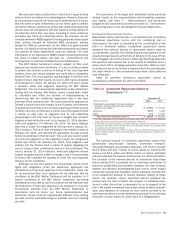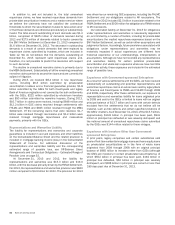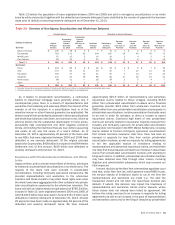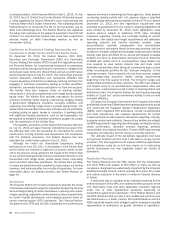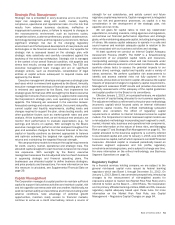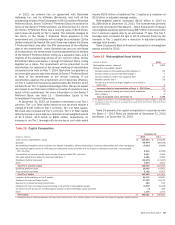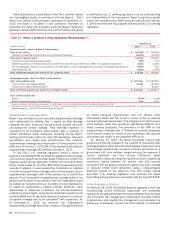Bank of America 2013 Annual Report Download - page 59
Download and view the complete annual report
Please find page 59 of the 2013 Bank of America annual report below. You can navigate through the pages in the report by either clicking on the pages listed below, or by using the keyword search tool below to find specific information within the annual report.Bank of America 2013 57
We submitted our 2013 plan in October and are required to update
it annually.
Similarly, in the U.K., the Prudential Regulation Authority (PRA)
has issued proposed rules requiring the submission of significant
information about certain U.K.-incorporated subsidiaries and other
financial institutions, as well as branches of non-U.K. banks
located in the U.K. (including information on intra-group
dependencies, legal entity separation and barriers to resolution)
to allow the PRA to develop resolution plans. As a result of the
PRA review, we could be required to take certain actions over the
next several years which could impose operating costs and
potentially result in the restructuring of certain business and
subsidiaries.
Orderly Liquidation Authority
Under the Financial Reform Act, when a systemically important
financial institution such as the Corporation is in default or danger
of default, the FDIC may be appointed receiver in order to conduct
an orderly liquidation of such systemically important financial
institution. In the event of such appointment, the FDIC could invoke
a new form of resolution authority, the orderly liquidation authority,
instead of the U.S. Bankruptcy Code, if the Secretary of the
Treasury makes certain financial distress and systemic risk
determinations. The orderly liquidation authority is modeled in part
on the Federal Deposit Insurance Act, but also adopts certain
concepts from the U.S. Bankruptcy Code.
The orderly liquidation authority contains certain differences
from the U.S. Bankruptcy Code. For example, in certain
circumstances, the FDIC could permit payment of obligations it
determines to be systemically significant (e.g., short-term
creditors or operating creditors) in lieu of paying other obligations
(e.g., long-term creditors) without the need to obtain creditors’
consent or prior court review. The insolvency and resolution
process could also lead to a large reduction or total elimination
of the value of a BHC’s outstanding equity. For example, the FDIC
could follow a “single point of entry” approach and replace a
distressed BHC with a bridge holding company, which could
continue operations and result in an orderly resolution of the
underlying bank, but whose equity is held solely for the benefit of
creditors of the original BHC. Additionally, under the orderly
liquidation authority, amounts owed to the U.S. government
generally receive a statutory payment priority.
Credit Risk Retention
On August 28, 2013, federal regulators jointly issued a re-proposal
of a rule regarding credit risk retention (Credit Risk Retention Rule)
that would, among other things, require sponsors to retain at least
five percent of the credit risk of the assets underlying certain ABS
and MBS securitizations and would limit sponsors’ ability to
transfer or hedge that credit risk. The proposed rule, as currently
written, would likely have some adverse impacts on our ability to
engage in many types of MBS and ABS securitizations and
resecuritizations, impose additional operational and compliance
costs, and negatively influence the value, liquidity and
transferability of ABS or MBS, loans and other assets. However, it
remains unclear what requirements will be included in the final
rule and what the ultimate impact will be on our results of
operations.
Consumer
Certain federal consumer finance laws to which the Corporation
is subject, including, but not limited to, the Equal Credit Opportunity
Act, Home Mortgage Disclosure Act, Electronic Fund Transfer Act,
Fair Credit Reporting Act, Real Estate Settlement Procedures Act
(RESPA), Truth in Lending (TILA) and Truth in Savings Act are
enforced by the Consumer Financial Protection Bureau (CFPB),
subject to certain statutory limitations. Through its rulemaking
authority, the CFPB has promulgated several proposed and final
rules that will affect our consumer businesses. On January 10,
2014, several significant CFPB rulemakings became effective,
including the Ability-to-Repay and Qualified Mortgage Rule and new
mortgage servicing standards. In addition, the CFPB has either
proposed or is considering rulemakings related to debt collection,
prepaid cards, integrated disclosures under RESPA and TILA, and
disclosures related to remittance transfer transactions.
Additionally, as noted above, in August 2013 several federal
agencies jointly re-proposed the Credit Risk Retention Rule, which
will impose credit risk retention requirements on sponsors
securitizing certain mortgage loans that do not meet the standards
of a “qualified residential mortgage” to be defined in the final
version of the Credit Risk Retention Rule. The Corporation is
evaluating the various rules and proposals to facilitate compliance
with these rules.
Managing Risk
Overview
Risk is inherent in every material business activity that we
undertake. Our business exposes us to strategic, credit, market,
liquidity, compliance, operational and reputational risks. We must
manage these risks to maximize our long-term results by ensuring
the integrity of our assets and the quality of our earnings.
Strategic risk is the risk that results from adverse business
decisions, inappropriate business plans, ineffective business
strategy execution, or failure to respond in a timely manner to
changes in the macroeconomic environment, such as business
cycles, competitor actions, changing customer preferences,
product obsolescence, technology developments and regulatory
environment. Credit risk is the risk of loss arising from a borrower’s
or counterparty’s inability to meet its obligations. Market risk is
the risk that values of assets and liabilities, or revenues will be
adversely affected by changes in market conditions such as
interest rate movements. Liquidity risk is the risk of an inability to
meet contractual and contingent financial obligations, on- or off-
balance sheet, as they come due. Compliance risk is the risk that
arises from the failure to adhere to laws, rules, regulations, or
internal policies and procedures. Operational risk is the risk of
loss resulting from inadequate or failed internal processes, people
and systems, or external events. Reputational risk is the potential
that negative publicity regarding an organization’s conduct or
business practices will adversely affect its profitability, operations
or customer base, or result in costly litigation or require other
measures. Reputational risk is evaluated along with all of the risk
categories and throughout the risk management process, and as
such is not discussed separately herein. The following sections,
Strategic Risk Management and Capital Management both on
page 61, Liquidity Risk on page 67, Credit Risk Management on
page 72, Market Risk Management on page 104, Compliance Risk
Management and Operational Risk Management both on
page 112, address in more detail the specific procedures,




